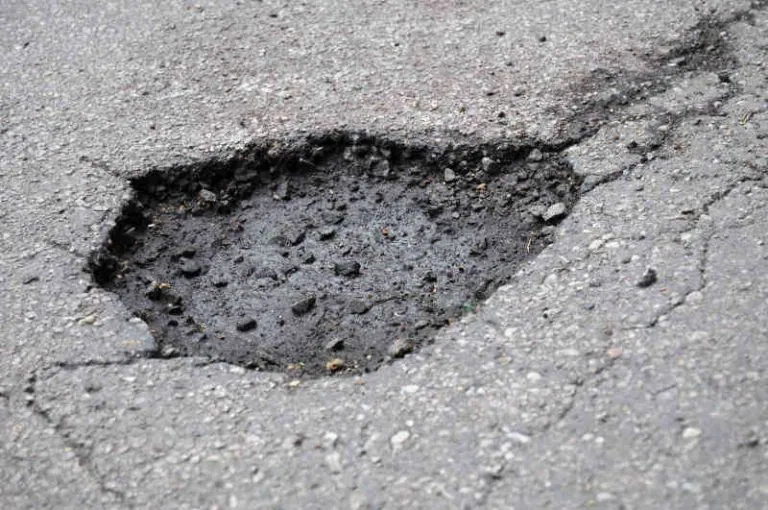Potholes are a problem that we all hate. When you drive over them, they can ruin your car. And they don’t care who you are or what you’re driving. Potholes form when the parking lot is damaged by water, cars, and salt from the winter ice storms. In Aurora pothole season happens in late February through early April of each year. But how do potholes happen? How can we stop them from happening? What do we do if a pothole has already formed?

Potholes can be created in many ways. They happen when the workmanship is bad, there’s a defect in materials or if the asphalt has reached its end of life. Potholes also form from water seeping into cracks and getting to the base below that becomes soft from being wet.
Freeze-thaw cycles cause the pavement base to expand, and traffic weakens the asphalt, making it crack more. When it gets hot, water will go into a hole under the pavement. This repeatedly happens over time; with each time, there is a bigger hole for more water to go in. As cars drive over the pavement, it gets weaker and weaker. When it finally breaks, it makes a pothole.
To avoid potholes in your parking lot, make sure water can’t get in. You need to take care of the problem before it starts. You should have an asphalt maintenance plan that will help you solve problems and keep you updated on what needs to be fixed.
Every two or three years, you should seal coat your parking lot. The sealcoating will fill hairline surface cracks in the asphalt, and it will slow down the oxidization of the asphalt keeping it from becoming brittle.
Additionally, part of your maintenance plan should be to have cracks sealed with a professional-grade sealant.
When there is a small hole in the parking lot, it can grow into a big hole. You will need to fix the problem now to avoid more expensive repairs later.
There are many ways to fix potholes. In Aurora, there are three main ways that we deal with them. Each method has a specific application and its pros and cons.
A cold patch is a temporary fix for potholes on roads. This mix of asphalt is either compacted with a roller or left as it is, and cars will roll over it to compact the patch. Cold patches are not a long-term solution, but they are good short-term for larger holes in high traffic areas. You may hear the term “Throw & Go” used to describe cold patch repairs.
Hot Patches are more difficult to do and take more time. They also cost more. But they provide a better type of repair for your parking lot that will last the rest of the life of your parking lot. We need to cut off part of the bad asphalt and make a rectangle to put the new hot patch. Clean out any water or debris from there, then apply tack on all sides, so it holds together better. Fill in with new asphalt, then make sure it is smoothed out and compacted with either a vibrating compactor or roller.
Infrared repair is a new type of repair for asphalt that doesn’t require any cutting and filling. It is also more cost-effective than hot patches but not as durable in the long term. The infrared method utilizes heat generated from ground-penetrating microwaves to soften the damaged area. The existing asphalt and new asphalt are mixed together, leveled and compacted.
A parking lot in Aurora is going to get potholes. Potholes can become costly if you do not take care of them right away. Shamblin Paving the leading asphalt contractor in Aurora has been fixing potholes for over 15 years. Please call for a free estimate.
Please complete the form below for a free no-obligation estimate.
Please complete the form below for a free no-obligation estimate.